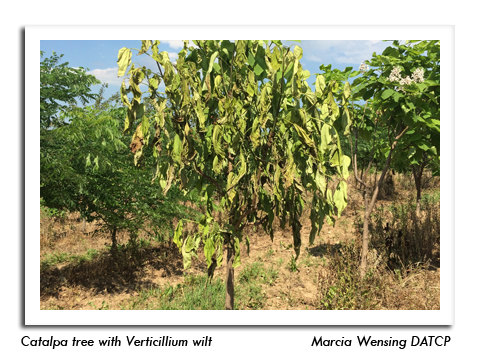
 |
|
|
Nursery & Forest
Volume 63 Number 17 Date 08/30/2018 LILAC BACTERIAL BLIGHT - Caused by Pseudomonas syringae pv. syringae, this bacterial disease was observed by inspectors on common lilac shrubs at several southern Wisconsin nurseries. Symptoms ranged from light to severe, with light symptoms appearing as leaf spots and severe symptoms exhibiting as leaf and shoot dieback. The pathogen overwinters on diseased plant tissue, therefore pruning infected branches well below the visibly infected area may help reduce reoccurrence. MAGNOLIA SCALE - This scale insect was recently found on magnolias at a nursery in southeastern Wisconsin. Early signs of infestation include yellowing of leaves, as well as leaf and stem dieback. As the largest of the soft-scaled insects found in the U.S., this very conspicuous species can range up to ½ an inch in size. Magnolia scale damages its hosts by removing sap and producing sticky honeydew that promotes sooty mold growth. Magnolia varieties commonly infested include 'Royal star', saucer, cucumbertree, and lily magnolia. Gardeners and nursery managers are advised to begin inspecting their magnolia trees and shrubs now for scale crawlers, and consider treating heavily infested plants with a crawler spray in late September. Minor infestations can be removed any time of the year by pruning out branches with scales. -- Shanon Hankin, DATCP Nursery Inspector VERTICILLIUM WILT - Catalpa and sugar maple trees in Racine and Washington county nurseries were showing symptoms of this fatal vascular disease, often misidentified as decline caused by seasonal or environmental factors. Verticillium is a soil-borne fungus that invades trees through weakened areas in their roots, progressing upward to infect the xylem structure and leading to blockage of water and nutrient uptake. Acute symptoms, including premature fall coloration, wilting, and defoliation, can progress to dieback that causes mortality. Trees with chronic symptoms often show slow growth and stunting, sparse foliage, leaf scorch, and abnormally heavy seed production. Best practices include keeping mulch two inches from the main trunks of trees and shrubs, pruning out dead branches as they occur, and sanitizing pruning tools between cuts. Regular watering during dry periods may help reduce symptom severity. Because the causal fungus persists in the roots and soil, diseased landscape trees should be replaced with a species not susceptible to the Verticillium fungus: birch, bur oak, ginkgo, hackberry, hawthorn, hickory, honey locust, mountain ash, poplar, serviceberry, white oak, willow, or with conifers such as fir, juniper, pine, or spruce. PEAR SAWFLY - Pear trees in La Crosse County were noted to have been severely damaged by the larvae of this insect. The black, slug-like larvae feed on the upper leaf surface, skeletonizing the leaves. Larvae first appear in June, feed for a month then drop to the soil to pupate. A second generation appears in August. Several control options are available including manual removal, horticultural oils and insecticidal soaps. -- Tim Boyle, DATCP Nursery Inspector 



|
|
|